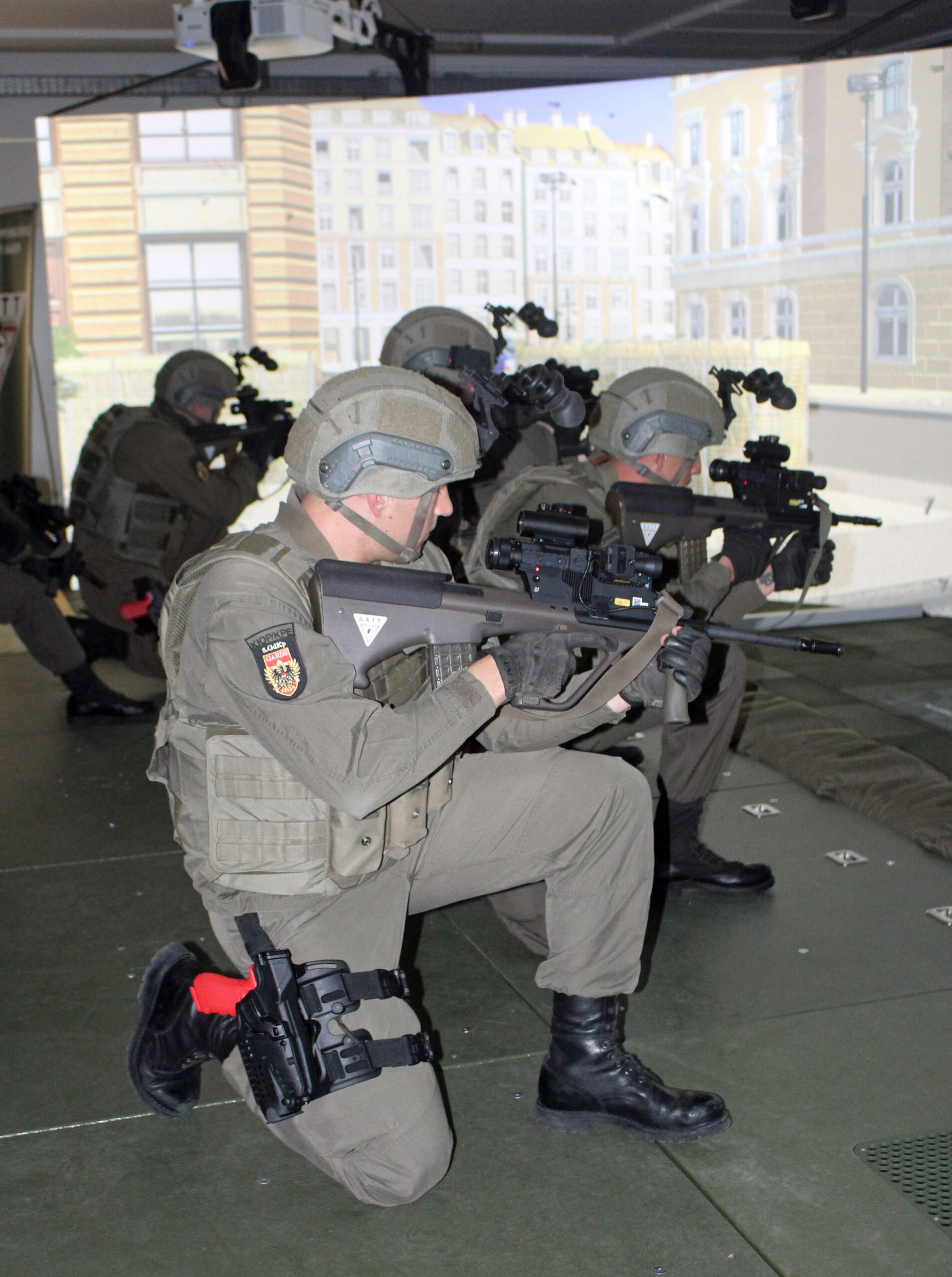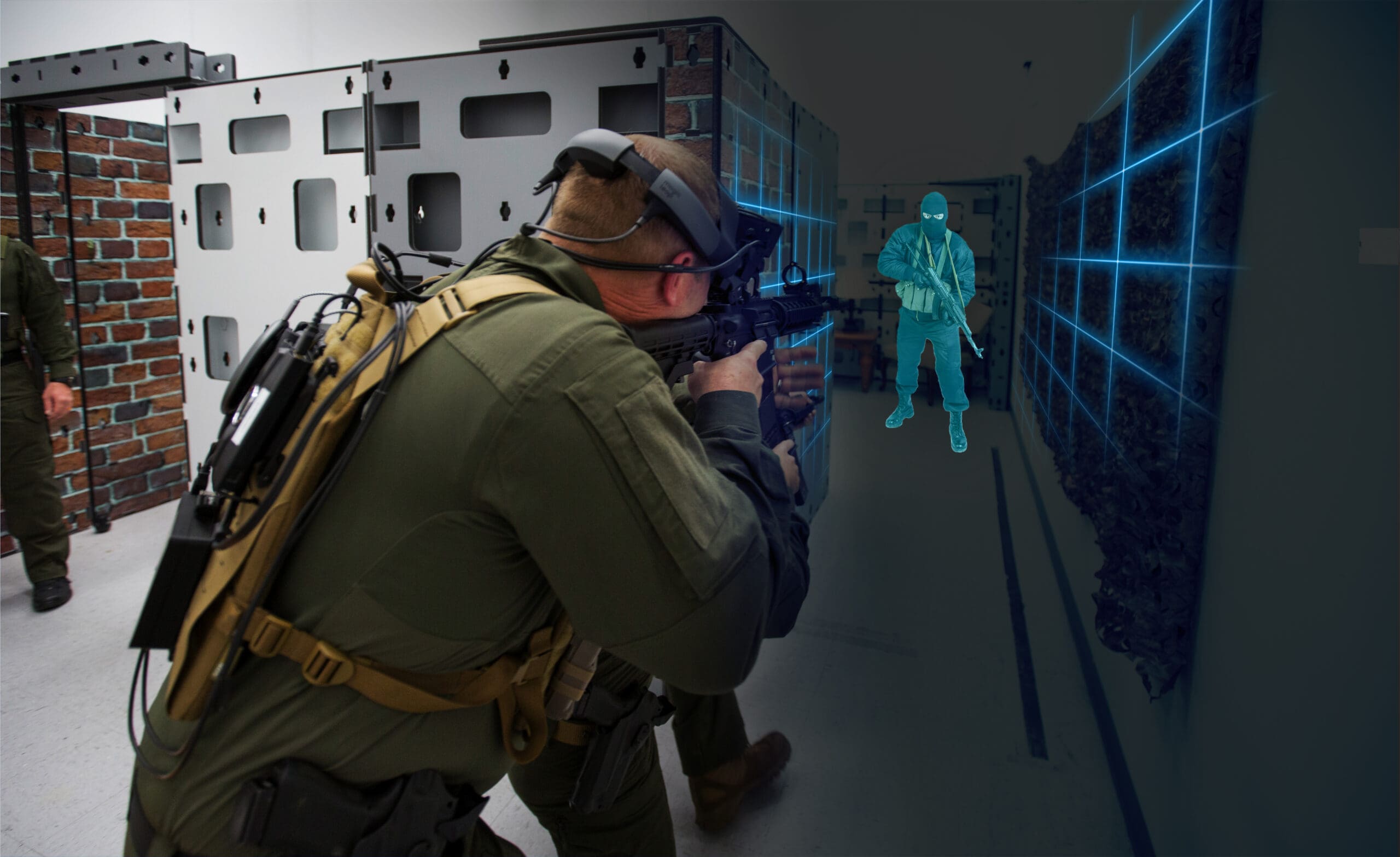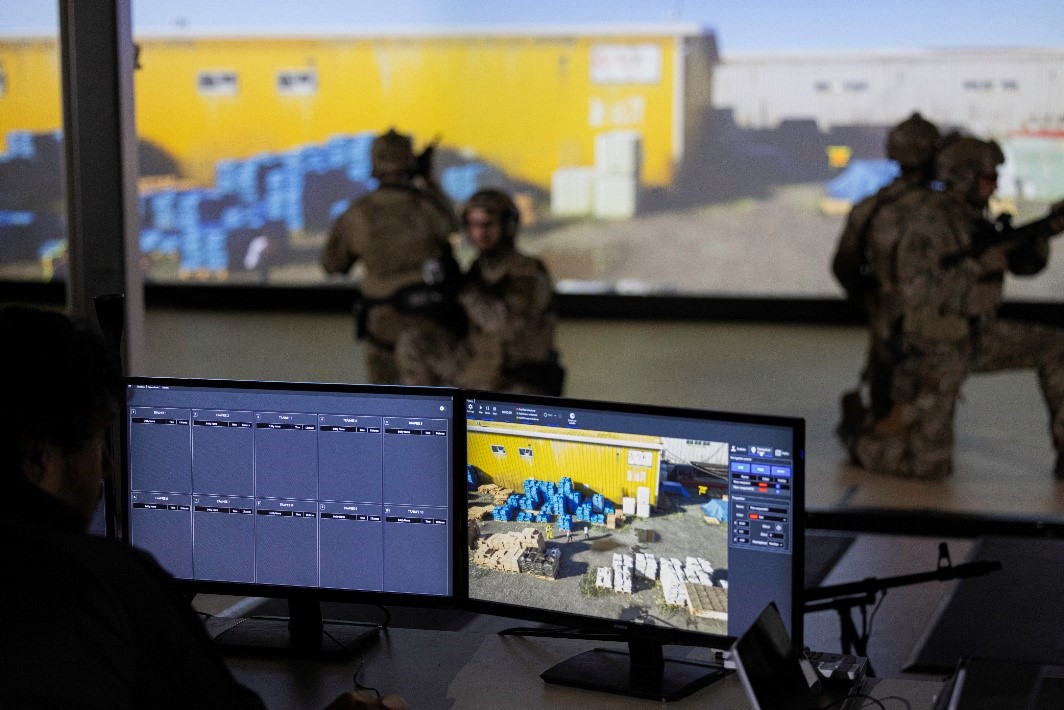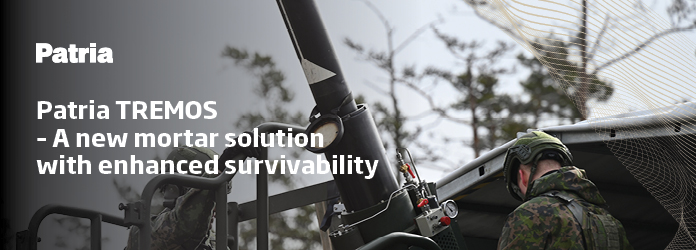The modern Virtual Small Arms Trainer (VSAT) has moved on from purely teaching marksmanship principles to enabling integrated squad tactical training to be conducted. New technologies are helping to achieve greater levels of immersion as the use of such systems spreads.
All soldiers carry some form of small arm, and teaching them to use that particular weapon comes with a number of challenges. Perhaps the first is the overall cost of such training. This includes the cost of ammunition, transportation to and staffing of the firing range, maintenance of that range and the environmental impact of live-fire training, in particular, noise and air pollution.
As well as these tangible factors, instructors have historically questioned the efficacy of teaching new soldiers live-firing skills on a range that was subject to the vagaries of different weather conditions; an environment considered less than ideal for one-on-one coaching and providing an inability to repeat accurately specific lessons or scenarios. This situation was also compounded by the noise, smells and recoil associated with the live-fire environment that the trainee was experiencing for the first time. In other words, the gulf between initial weapon handling in the classroom and live-fire ranges generated poor ‘training transfer’.
Around sixty years ago the military began to address these issues in an attempt to close this training transfer gap. The initial attempt used sub-calibre inserts that were used in full-calibre weapons to allow soldiers to conduct live-fire practise on indoor ranges, frequently using cine-film targets. In the case of the British Army, this saw a .22 barrel insert and modified magazine used to adapt the standard issue L1A1 Self Loading Rifle.
With the adoption of computer generated imagery (CGI) in the late 1980s, VSATs began to appear on the market. These initial devices simply replicated linear gallery and electronic target ranges (ETR), and were uniquely used for marksmanship training. Such devices enabled soldiers to transition from the classroom where weapon handling, basic aiming and stoppage drills were taught, to the live-fire range. This transitionary experience provided an environment where instructors could prepare trainees for what they would experience on the live-fire range in terms of its layout, the range orders/commands that they would hear there and the firing practises that they would undertake.
Early VSATs also provided an environment where soldiers could be taught the importance of stable firing positions and the correct breathing techniques. They were also used to teach how to correctly squeeze the trigger, the effects of weapon cant (positioning the weapon left or right of the vertical) and how to ‘lead’ moving targets. Another significant advantage was that VSATs generated data that could be used to correct a soldier’s individual errors. These errors could be evaluated by consecutively running exactly the same exercise to see if they had been eradicated.
“These early generation VSATs certainly boosted marksmanship training and served a very valuable purpose but they did not address the needs of the infantry squad and the weapons that they used on the battlefield,” Hans Lindgren, Saab’s Head of Business Development told ESD. “Our System Ground Combat Indoor Trainer (GCIT) allows individual shooting and engagement training, against static and moving targets, and tactical training with a focus on decision-making, communication and coordination of fires.”
The arrival of systems such as Saab’s GCIT, the Guardiaris Small Arms Tactical Trainer (SATT) and the Thales SATIS (Small Arms Trainer Indoor Simulator) provided the ability to incorporate a variety of squad weapons, along with the integration of indirect fire weapons such as mortars. Crucially, these modern VSAT devices are modular and can be upgraded with new weapons or ‘technology refreshes’ as improvements become available.

Credit: USMC
An exemplar of such an approach can be found with the US Marine Corps and its Indoor Simulated Marksmanship Trainer (ISMT). The current iteration, ISMT III, is now being upgraded to accommodate enhancements to the M252 81 mm mortar.
Designed by InVeris Training Solutions – formally FATS and then Meggitt Training Systems – ISMT allows marines to train at any time of the day or night. “There’s no weather restrictions, there’s no range restrictions, there’s no environmental restrictions, Marines can come in here anytime as long as they schedule it, allowing combat readiness to be at its peak,” explained Chief WO 4 Harry Taylor from the 3rd Marine Littoral Regiment in Hawaii. The ability to train M252 mortar crews virtually is a vital one in Hawaii considering that “Marine Corps Base Hawaii doesn’t have the ability to live fire 81 mm mortars,” added Taylor.
Enhancing Capability
Like the USMC, many armed forces are looking to improve the capabilities of their VSAT devices. In Europe, the Austrian Army commissioned its first Guardiaris SATT, located at Bruckneudorf, in 2022 and since then devices have been installed at five other locations.
Each SATT comprises a parabolic projection screen with a 148° horizontal field-of-view, four projectors, four speakers to provide surround sound, a shock/vibration floor, and an instructor operator station (IOS). The IOS allows the instructor to manage exercise preparation, create scenarios, monitor the scenario and then conduct an after action review (AAR). The high-fidelity visual system is a games-based solution developed by Guardiaris and integrated with its Guard operating software that features variable time-of-day, night, different weather conditions and NVG options. Unlike competitor systems that use laser technology, SATT uses a patented IR tracking solution to accurately monitor squad members’ positions and weapon alignment.
“Over the last two years we have also added short-range anti-tank weapons and a remote sniper capability,” Maj Roland Nagl, the Austrian Army’s SATT project leader told ESD. “We are also looking to integrate a Remote Weapon System (RWS) capability that was developed by Guardiaris in partnership with ITEC GmbH, Madritsch and Instalaza through the Future Integrated Indoor Soldier Training (FIIST) initiative that has been funded by the European Defence Industrial Development Programme.”

Credit: Trevor Nash
As well as these enhancements to SATT, the Austrian Army is also looking to rationalise its complete approach to the application of VSAT. Maj Nagl describes this as “integrating more scenarios” and “capturing and using data to improve training.” The ultimate aim is to provide a seamless training pipeline that encompasses virtual and live training domains.
“We are about to implement a new, modern training concept,” Col Wolfgang Habitzl from the Austrian Army’s department for weapon systems, ammunition and simulation told ESD. “This concept is focused on the topic of firing operations and starts from the very beginning of the training of a single soldier up to unit level. It will combine all training assets you need for this training and the current project focuses on individual to squad levels.”
Col Habitzl said that this two phase project will initially see the integration of three VSAT devices and use MantisX and Cervus XCALIBR software to provide data with which to assess and improve training. As well as SATT for fire-team to squad training, the Austrian Army also currently uses the Smokeless Range Trainer (SRT) from Laser Training Solutions for individual marksmanship training. It is expected to procure the Guardiaris Small Arms Mobile Trainer (SAMT) for pairs to fire-team training in the near future.
Central to these changes are the data capture and the associated “data analysis” process to “help us identify key performance indicators to allow us to define better training,” Col Habitzl explained. “We also want to be able to display these data in a meaningful and easy to understand way.”
The Austrian Army is also looking at additional components to enhance the efficacy of its weapon training process still further. These include eye tracking, capturing communications data to include voice and hand signals and monitoring individual biometric data such as heart rate and perspiration levels. This monitoring would take place in both the virtual and live training environments and focus, according to Col Habitzl, on the “continuous collection of performance data throughout the whole training programme” to allow the creation of “a profile of individual soldiers, teams and units.”
Projects like the one currently underway in Austria highlight the challenges facing the military in trying to make live fire exercises realistic. The reason is that military ranges, gallery or ETR, are constructed linearly and targets are generally always in front of the firer for obvious safety reasons. Safety is not an issue in the virtual world, but technical issues have historically meant that VSATs have generally mirrored the real-world linear range.

Credit: InVeris
In addressing this issue, InVeris Training Solutions has developed augmented and virtual reality-based (AR/VR) products that provide a 360° environment. Both the SRCE and SURVIVR products see the trainee wearing a high-resolution headset to provide both visual and auditory cues. The company says that the visual cues are, “overlaid on the physical world, generating obstacles, virtual characters, avatars, and assets.”
Enhancing Immersion
One of the key elements of success for any virtual trainer is its ability to immerse the trainee in a simulated world – the so-called ‘suspension of disbelief’. This is achieved by stimulating the trainee’s senses as they would be in the real world. The major human sense is vision and current VSAT systems are tending to move towards games-based visualisation systems such as Bohemia Interactive’s VBS4 or Epic Games’ Unreal Engine.
In the US for example, VSAT vendor Laser Shot has used VBS for a number of years across a range of products while in late 2023, Virtra announced that it had integrated VBS4 with its own Virtra Operating System (VOS). The major benefit of this approach is that users can create their own geospecific virtual environments to allow their VSATs to exactly replicate actual firing ranges and also be used for mission rehearsal. Starting this year, simulators with VBS4 integration started being made available to new customers, while existing VOS clients will have the option to upgrade their simulators.
Historically, military users of virtual training systems have used separate Computer Generated Image (CGI) engines for different simulation systems along with a variety of simulator specific databases. A significant benefit of games-based CGI is that they are currently used by a number of nations across a range of simulation systems. According to VirTra’s CEO John Givens, the integration of VBS4 allows users to, “leverage their investment in models, terrain, scenarios and other integrated components instantly for part task and collective training.”

Credit: Thales
Although visualisation is seen as the key to immersion, little effort has been expended by VSAT manufacturers on generating olfactory stimulation. Smell is an important human sense that helps immerse the individual in a simulation, but little has been done in this area. One exception was Cubic Defense that has demonstrated olfactory stimulation as part of its VSAT to simulate the smells typically associated with an Afghan village. Many consider that for the costs involved such an enhancement would be well worth the investment.
In Europe, the Royal Netherlands Army (RNLA) has embarked on a project to enhance the visual fidelity of its current VSAT devices with a longer term aim of eventually procuring a new system. The RNLA uses the Thales Sagittarius trainer that features the open platform Crystal Space video game engine. First developed in 1997, Crystal Space has been described as “effectively dead and has been for a good number of years”, hence the RNLA’s efforts to upgrade its VSATs.
“We have 38 fixed Sagittarius systems and two mobile systems, and the plan is to upgrade to the Sagittarius Evolution platform,” Sake Blaauw, head of the RNLA’s small calibre simulation bureau explained to ESD. “The conversion process is expected to take around a year and we expect the last system to be converted at the end of 2025.”
The Thales Sagittarius Evolution uses the Unreal Engine 5 following the company’s signing of a partnership agreement with Epic Games in late 2022. In addition to the new visual system, the latest VSAT iteration from Thales features improved weapon simulation including, “high fidelity [weapon] replicas with pneumatic recoil featuring a detailed ballistics model. In conjunction with telescopic, night vision and thermal sight simulators, they allow users to train as closely as possible to real conditions.”
The added fidelity that Sagittarius Evolution provides will allow the RNLA to eventually conduct “90% of its training in the simulator,” Blaauw told ESD. As to the eventual replacement of Sagittarius Evolution, “it is not yet clear what the new system will look like, but we recently started developing plans for the new trainer that will enter service in 2030.”

Credit: FAAC
As to the future of VSAT, the adoption of an AR solution by InVeris is indicative of how technology is being used to add capability. In the US, the US Army is currently advancing with its Synthetic Training Environment (STE) programme and in particular, the Soldier Virtual Trainer (SVT), part of which focuses on Weapon Skill Development (WSD). In essence, STE provides a common visualisation package that can be used across a multitude of applications and in many ways reflects the way that CGI products such as VBS4 and Unreal Engine are being adopted by many nations across the world.
It is not all about the mature users of simulation such as the US, UK, the Netherlands or Austria. Through its Foreign Military Sales (FMS) structure, the US Army’s International Programs Office is supplying VSATs to a number of its allies throughout the world. These include a Laser Shot Mobile Marksmanship Training System (MMTS) to Albania, InVeris Training Solutions Engagement Skills Trainer II (EST II) to AFRICOM for use by Senegal, Ghana, Togo, Uganda and Rwanda as well as providing an upgrade to Jordan’s EST 2000.
Closing thoughts
Although VSATs have been used for around 40 years, modern technologies have enabled them to evolve from purely teaching marksmanship to embracing tactical engagements including fire and manoeuvre, shoot/no-shoot decision making skills and incorporating the full range of squad individual and crew-served weapons. Primarily used for training, such systems can also be used for mission rehearsal.
These added capabilities have made the modern VSAT an excellent tool for transitioning the soldier from the classroom to the live-fire range. Historically, many armies have viewed these virtual and live phases of training as separate entities. However, as the Austrian Army is highlighting with its current project, they need to be considered together to maximise training effect.
Trevor Nash



